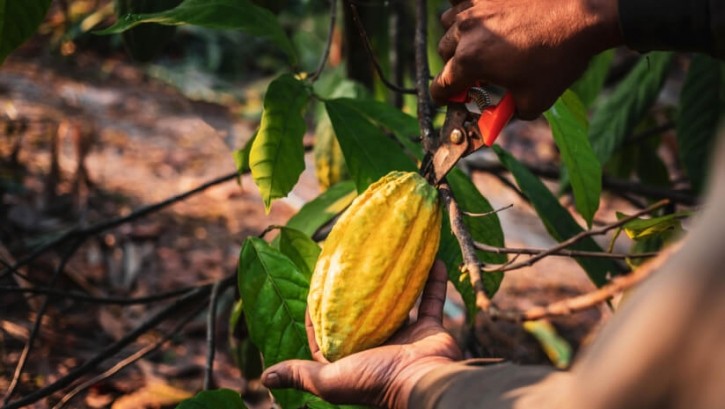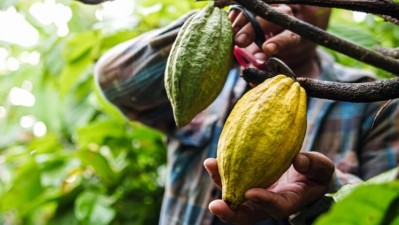Cocoa crisis: Ghana’s output almost halves

Amid a third difficult season for cocoa farmers, the latest figures on cocoa output fail to stave off ongoing worries from within the sector. With the current harvest almost complete, Ghana’s cocoa output is more than half its average, the country’s government-led cocoa board Cocobod reports.
As of July 16, this figure sits at 429,323 metric tonnes, data from Cocobod indicates. With the harvesting season closing at the end of June, this amounts to less than 55% of Ghana’s average seasonal output.
Cocoa production in Ghana
Ghana is the second largest cocoa producer in the world, contributing around a fifth of the world’s cocoa every season, the OPEC fund for International Development details. Together, Ghana and the Ivory Coast account for around 60% of global supply.
Ghana’s annual cocoa output typically averages 800,000 tonnes, according to International Cocoa Organization (ICCO) data. In the 2020/2021 season, Ghana’s production peaked to 1047 thousand tonnes of cocoa beans, Statista reports.
Yet disruptions have affected the country and the world’s leading cocoa producer, Ivory Coast, for consecutive seasons. So far this year, rising global cocoa prices have been a huge concern. And production has reduced significantly. Cocoa production output for the entire season was 683,269 tonnes in 2021/22 and 656,140 tonnes in the 2022/2023 season.
The last three seasons have seen climate change-related disasters spur disruptive weather patterns that destroy crops and spark global concern in the chocolate sector throughout Ghana and the Ivory Coast. This fate affects both of the two leading producers. Mining and smuggling, however, are unique to Ghana, applying additional pressure to an already struggling sector.
Multiple factors to blame
Dwindling cocoa production volumes have remained, causing chaos within chocolate manufacturing and huge concerns for farmers’ livelihoods.
Ashanti and the Western South are two of the major regions within Ghana. They have traditionally been the most significant contributors to the overall drop in production. Yet, in the current cocoa landscape, they have been severely affected.
By the end of June, Ashanti had produced 103,976 tonnes of beans, compared to 160,855 tonnes in the 2022/23 season. Western South, meanwhile, recorded production of 96,810 tonnes by the end of June, compared to 152,277 tonnes last season.
Swollen shoot disease (CSSVD) is primarily responsible for the drop in production in Ashanti and the Western South. Roughly 81% of the Western North region, which handles most of Ghana’s cocoa production, has been affected by CSSVD, The Cocoa Health and Extension Division (CHED) of the Ghana Cocoa Board reports. This amounts to 330,456 hectares out of 410,229 hectares.
In July, Cocobod announced it had teamed up with Mars Wrigley to develop a kit designed to identify CSSVD in its early stages. “Investing in cocoa research is crucial to tackling the problems farmers face in cocoa production,” Ellen Jacobs, Global Corporate Affairs Manager for Cocoa at Mars Wrigley, said at a Cocobod event.
Seeking supply and price stability
Supply restrictions and price increases defined the cocoa market at the beginning of June, the ICCO published in its monthly report. Far from stable, the month saw several price swings during the first half of the month.
Costs for cocoa were at their highest by June 13, increasing by 18% in London from $9,798 per tonne to $11,530 per tonne compared to an average of $3,182 last year. In the same period, New York saw prices grow 12% this season from US$9,590 per tonne to US$10,782 per tonne compared to the previous season’s average of $3,159 per tonne.
While cocoa prices in both London and New York are affected, the severity of this is felt more in London. As most of West Africa’s cocoa comes to Europe, the ICCO report details that this has a more significant impact in London.
Citing Reuters, the ICCO details how these rising prices came from supply worries in Ghana. These growing concerns and poor crops have led to the country planning to push delivery of up to 350,000 tonnes of cocoa beans until next season.
However, Ghana is not alone here, with the Ivory Coast also expected to have to delay forward sales of 940,000 tonnes of next year’s sales, approximately 35% less than the previous season. Cocoa producers are waiting for clarity.
Joseph Boahen Aidoo, CEO of Cocobod, held a meeting to discuss the challenges faced by farmers and the future of the Ghana cocoa industry. Emphasising that cocoa costs are governed by the forces of demand and supply of cocoa, he detailed plans with forward sales. The CEO explained that the forward sales strategy aims to mitigate the risks and uncertainties associated with spot sales and helps to secure better, more predictable prices.
“Unfortunately, in the past year, there has been an inversion because of the effects of El Niño,” Aidoo said at an industry event. As reported in Confectionery News, El Niño, the weather phenomenon that describes climate change fluctuations, has been driving cocoa price hikes since last season.
Hope for future harvest
How can manufacturers survive the cocoa crisis?
Soaring costs and a dwindling supply of cocoa mean innovation and creativity are essential for chocolatiers who hope to weather the supply storm. Read our report.
The cocoa harvesting season runs from October to June. With the 2023/2024 season approaching, producers naturally turn to look at what they can expect from the next season.
All chocolatier’s eyes are now firmly on the next harvest season, which begins in October 2024. The CEO of Cocobod has said he anticipates that cocoa output will flourish once more to produce over 800,000 tonnes of cocoa over the 2024/2025 season.
Furthermore, Ghana’s mid-crop season starts in July. Financial industry data provider Barchart says projected production output in the country’s mid-crop season has been reduced from 25,000 tonnes, a significant drop from its previous figure of 150,000.
Both Ghana and the Ivory Coast sell their harvests forward. Yet, with the shortfall in this season’s harvest, Ghana’s Cocobod cannot deliver enough cocoa to fulfil its contracts with exporters and traders. Following the possibility of better harvests next season and subsequent price drops, traders may sell more cocoa now and buy trading contracts later at a lower price to make more profit, the ICCO details.


















